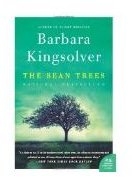Novel Reviews: Teaching the Bean Trees by Barbara Kingsolver
Literary Merit (5 out of 5)
Teaching The Bean Trees by Barbara Kingsolver can be a rewarding literary experience.
The Bean Trees tells the story of Taylor Greer, a poor Kentuckian whose main goals in life are not getting pregnant and getting away. She ends up in Tucson but not before inheriting an abandoned Indian girl for whom she must care.
Teachers may emphasize the following literary devices:
- metaphor, simile, personification, etc.
- irony: verbal, situational, and dramatic
- foreshadowing
- characterization
- meiosis and hyperbole
- conflict: individual v. society
Teaching The Bean Trees may involve discussing the following social issues:
- teen pregnancy
- goals and dreams
- abused children
- divorce
- sin
- right v. wrong
- social injustice
- abandonment
- family
- immigration
- prejudice and racism
Student Readability (4 out of 5)
Teaching any novel becomes easier if students actually enjoy it. The novel’s style lends itself to enjoyable reading and most students have little trouble understanding the language. From a reading level standpoint, the novel is suitable for high school honors or regular. Some things you may want to explain include specialized vocabulary, background on immigration issues, making inferences, and figurative language.
Students who understood the novel enjoyed it. Girls were more likely to enjoy it than boys: girls are more mature and the novel is better enjoyed by mature readers; the novel’s main characters, Taylor, LouAnne, and Mattie are female.
Appropriateness: Part 1
Teaching The Bean Trees will not be without controversy. If you decide to teach it, it may be wise to know what’s in it.
p. 6 “I knew the scenery of Greenup Road which we called Steam-It-Up road…and none of these sights has so far inspired me to get hogtied to a future as a tobacco farmer’s wife.”
p. 12 Jolene says, “…My daddy’s been called me a s— practically since I was thirteen, so why the hell not?”
p. 31 “When I pulled off the pants and the diapers, there were more bruises. Bruises and worse…I had never even thought about such things being done to a baby girl.”
p. 42 “Fanny Heaven … she just had to ignore. There was something primitive about the painting on the door, as though the leopard-bikini lady might have been painted by a schoolchild, except that she was positioned in such a way that the door handle, when a person pushed it, would sink into her crotch.”
(1 out of 5)
Lou Ann and Taylor discuss other uses for a wrench which refers to the Valentine’s Day card Taylor sends to her mom. The card reads: “Here’s hoping you’ll soon have something big and strong around the house to open those tight jar lids.” Inside the card is a picture of a pipe wrench.
The card is humorous, but on p. 119 the discussion gets a bit bizarre when Taylor shows the card to Lou Ann who says_, “I could use a good wrench around here. Or better yet, one of them…what do you call ’ems? That one that’s shaped like a weenie?”_ They go on to discuss other tools and buildings that look weenie-like, including the Washington Monument.
p. 150 “Just because I don’t go chasing after every Tom’s Harry Dick that comes down the pike…”
pp. 169-170 Note the discussion of an article in the tabloids where a twin baby girl was born pregnant after having had sex in the womb with her twin brother.
p. 174 T_here is a graphic scene of two tortoises mating at the zoo. “The giant tortoise, I noticed, had caught up to its partner and was proceeding to climb on top of it from behind. Its neck and head strained forward as it climbed, and to tell the truth, it looked exactly like a bald, toothless old man. The knobby shells scraping together made a hollow sound. By the time Lou Ann came back from the bathroom, the old fellow on top was letting out loud grunts that rang out all the way down to the military macaws.” (just really weird)_
p. 203 A_fter getting a job at Red Hot Mama’s salsa factory, Taylor says, “The ones that handled the chiles grew accustomed to tingling fingertips, and learned never to touch their private parts (or anyone else’s) not even on their days off.”_
p. 228 A reference to Fanny Heaven where they show “disgusting little movies…some of them with kids. Did you know that? Little girls! A guy at work told me. It (the attack at the park) had to have been somebody that saw those movies, don’t you think? Why else would it pop into a person’s head?”
Famed literary critic, Carrie Fleming remarks, “Keep in mind that these quotes, when taken out of context seem more extreme on their own. The content, in my opinion, is too mature for some ninth graders: infant molestation, references to prurient reading material, twins having sex in the womb, jokes about men’s anatomy, etc. The bottom line is that it’s a good book for the right audience, but I’d rather let the parents make that decision for their own kids and not suggest it as reading for the entire class.”
This post is part of the series: Novels for the High School Classroom
These reviews highlight potential novels for high school English classes.
